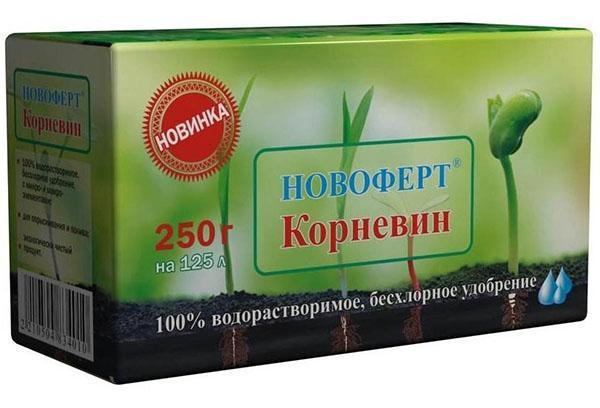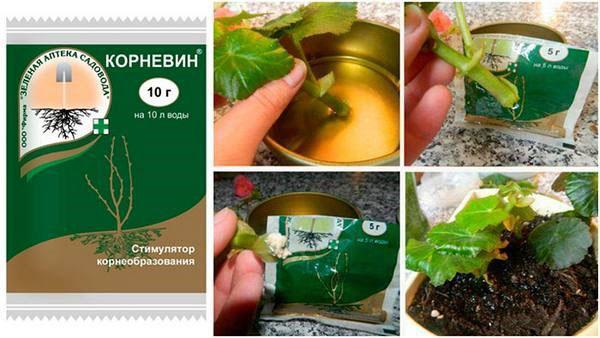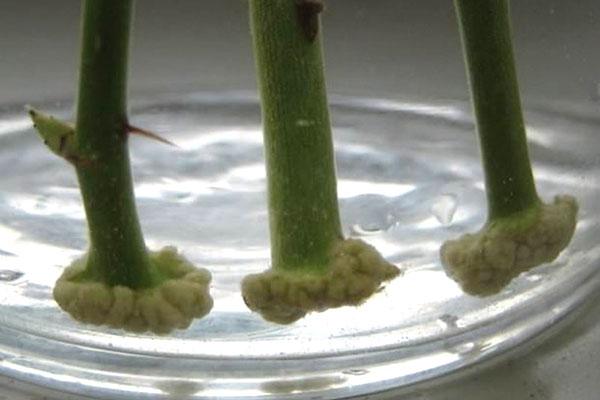We will learn all the subtleties of vegetative reproduction using the phytostimulator Kornevin
 A beautiful, healthy and fruitful plant is distinguished primarily by a developed root system. With the vegetative method of propagation, cuttings do not take root well, primarily due to weak root formation, and biostimulant fertilizers can help them in this. Kornevin is one of the most popular preparations containing everything necessary for building up the root mass. In order for it to be beneficial and not harm, you need to learn all the subtleties of application before use.
A beautiful, healthy and fruitful plant is distinguished primarily by a developed root system. With the vegetative method of propagation, cuttings do not take root well, primarily due to weak root formation, and biostimulant fertilizers can help them in this. Kornevin is one of the most popular preparations containing everything necessary for building up the root mass. In order for it to be beneficial and not harm, you need to learn all the subtleties of application before use.
Description of the root and its effect on plants

 Indolylbutyric acid (IBA) has this effect. Once in the soil, it is converted into the natural hormone of root formation, heteroauxin. This drug differs from its predecessor in a longer action.
Indolylbutyric acid (IBA) has this effect. Once in the soil, it is converted into the natural hormone of root formation, heteroauxin. This drug differs from its predecessor in a longer action.
The composition of the root, in addition to the IMC, includes macro- and microelements that promote root formation - potassium, phosphorus, manganese and molybdenum.
The drug is available in packs of 4, 5, 10, 125 and 250 g and is a cream-colored powder. It is used both in dry and liquid form.
The stimulant has the following effect:
- promotes rapid and friendly seed germination;
- stimulates the formation of the root system in cuttings;
- reduces stress and improves the survival rate of seedlings and seedlings;
- increases the resistance of plants to unfavorable natural factors - a lack or excess of moisture in the soil, sudden temperature changes.
 All this does not mean that a plant treated with root root will not be susceptible to pests and diseases. It is not a substitute for organic or mineral fertilizers, but only contributes to the development of a powerful root system, which is the basis of the very existence of the plant. In the photo below: on the right, the root system of the cutting, which was treated with root, on the left - a control sample.
All this does not mean that a plant treated with root root will not be susceptible to pests and diseases. It is not a substitute for organic or mineral fertilizers, but only contributes to the development of a powerful root system, which is the basis of the very existence of the plant. In the photo below: on the right, the root system of the cutting, which was treated with root, on the left - a control sample.
How to use the drug according to the instructions
 The root former can only be beneficial if used correctly. To do this, you must follow the instructions for use of the root. To prepare working solutions, use only earthenware, enamel or glassware.
The root former can only be beneficial if used correctly. To do this, you must follow the instructions for use of the root. To prepare working solutions, use only earthenware, enamel or glassware.
When used dry, the cut of the cutting is dipped in powder and after a while dipped in water or immediately dropped into the ground. Cuttings cut for grafting are also recommended to be powdered with root.
Experienced gardeners are advised to mix the drug with any fungicide in a ratio of 10 to 1. This additive activates the plant's immunity and protects the slices from fungal attack.
To prepare a solution for 1 liter of warm water, take 1 gram of powder. The resulting material is mixed well and used immediately. Tubers and bulbs are soaked in the working solution for 20 hours, the same amount can be soaked in the root and seeds. Then the treated planting material is planted in the ground. For better survival of seedlings, the holes are first spilled with clean water and then with a root solution.Next, seedlings are planted, the earth is compacted and watered with a root former again. When watering, adhere to the following recommendations:
- 2-3 liters for tree seedlings and large shrubs;
- 0.3 l for low and medium-sized bushes;
- 40-50 ml for flower and vegetable seedlings.
Before planting apple, plum, pear, sweet cherry, quince, cherry seedlings, the roots are kept in a root solution for 10–12 hours. Add 1 teaspoon of powder per liter of water.
The opened packaging is used immediately. The remaining powder should be poured into a tightly curled container. The aqueous solution cannot be stored.
Application for seedlings
 Instructions for the use of root for seedlings provides for keeping the seeds in an aqueous solution for two hours. Crops that do not tolerate root damage are watered with a stimulant during the pick and two weeks after it. In order not to harm the sprouts, you need to know how to properly dilute the root for watering the seedlings. The working solution is prepared at the rate of 1 g of the drug per 1 liter of water. One plant requires no more than 60 ml of a liquid product. An overdose causes inhibition of the growth of the seedling, therefore, the seedlings are watered, carefully measuring the amount for each bush.
Instructions for the use of root for seedlings provides for keeping the seeds in an aqueous solution for two hours. Crops that do not tolerate root damage are watered with a stimulant during the pick and two weeks after it. In order not to harm the sprouts, you need to know how to properly dilute the root for watering the seedlings. The working solution is prepared at the rate of 1 g of the drug per 1 liter of water. One plant requires no more than 60 ml of a liquid product. An overdose causes inhibition of the growth of the seedling, therefore, the seedlings are watered, carefully measuring the amount for each bush.
When transplanting grown seedlings into the ground, you should be guided by the weather. On sunny and warm days, the drug is inappropriate to use, since additional stimulation of root formation will stop the growth of the aerial part and slow down the onset of fruiting. Favorable weather conditions themselves contribute to the development of the root system and the further growth of the plant. It will be more beneficial to use the root for seedlings in a prolonged cold spring, when the earth is weakly warmed up by the sun. Sprouts at such a time spend a lot of energy on overcoming unfavorable conditions and transplanting into the soil turns out to be painful. To help young plants take root and maintain strength, a biostimulant is used. The powder solution is prepared according to the standard scheme described on the package.
Each bush is watered individually, under the root, so as not to cause rapid growth of weeds.
Also, the roots of the seedlings are kept in the working solution for several hours immediately before planting in the ground. If the seedlings are well rooted and actively grow, the root is no longer used.
Kornevin for indoor plants
 Instructions for the use of root for indoor plants suggests several options for its use:
Instructions for the use of root for indoor plants suggests several options for its use:
- soaking seeds in an aqueous solution for 2–3 hours;
- dusting of cuttings or leaves;
- keeping cuttings in one solution.
If the root is used dry, then the cut of the cutting is moistened with water and dipped in powder. Then the excess of the drug is shaken off, and the cutting is planted in the ground or flower pot. Some plants will thrive better if kept in a stimulant solution until roots appear.
Kornevin is used if cyclamen, orchid or gloxinia die from improper care. Before sending gloxinia or cyclamen to forced rest, cut off all damaged and rotten roots. The remaining healthy roots are kept in the working solution for several hours before transplantation.
 Kornevin is capable save the orchid with a rotten root. All diseased roots are cut out, then the flower is kept in the dark for two hours at a temperature of about 27 ° C. This procedure helps the slices dry out and not rot again. A fresh root solution is prepared, an orchid is placed in it and kept in a warm room until new roots form.
Kornevin is capable save the orchid with a rotten root. All diseased roots are cut out, then the flower is kept in the dark for two hours at a temperature of about 27 ° C. This procedure helps the slices dry out and not rot again. A fresh root solution is prepared, an orchid is placed in it and kept in a warm room until new roots form.
Rooting grape cuttings
 For rooting grape cuttings the root is used both dry and diluted in water. This culture is easily propagated by cuttings, but if there is very little planting material or the variety is especially valuable, you should play it safe and use a root former.
For rooting grape cuttings the root is used both dry and diluted in water. This culture is easily propagated by cuttings, but if there is very little planting material or the variety is especially valuable, you should play it safe and use a root former.
 The dry method is more reliable, it will require a greater consumption of powder and is dangerous with the likelihood of rotting of the cutting. It is used if the selected variety does not take root in the solution. The dry method is used if, after 2 weeks of rooting, no callus has occurred in the solution. The stalk should be carefully examined under a magnifying glass: if at least microscopic influxes are noticeable, it should be left in an aqueous solution.
The dry method is more reliable, it will require a greater consumption of powder and is dangerous with the likelihood of rotting of the cutting. It is used if the selected variety does not take root in the solution. The dry method is used if, after 2 weeks of rooting, no callus has occurred in the solution. The stalk should be carefully examined under a magnifying glass: if at least microscopic influxes are noticeable, it should be left in an aqueous solution.
How to root a rose from a bouquet using root
 Sometimes on stems roses from the bouquet, green buds are formed in place of the torn leaves. If you like the variety, you should try to root the stalk. To do this, the stem is cut at the bottom and top, leaving 3 healthy swollen buds.
Sometimes on stems roses from the bouquet, green buds are formed in place of the torn leaves. If you like the variety, you should try to root the stalk. To do this, the stem is cut at the bottom and top, leaving 3 healthy swollen buds.
 The lower part of the stem from the cut to the lowest bud is scratched with a sharp knife to make it easier for the roots to germinate. Then this place, including the cut and the lower bud, is dipped in the root, and after a few minutes, the excess is shaken off and the cutting is planted in the planting container. The top two buds should remain on the surface. It is advisable to use a special soil for roses.
The lower part of the stem from the cut to the lowest bud is scratched with a sharp knife to make it easier for the roots to germinate. Then this place, including the cut and the lower bud, is dipped in the root, and after a few minutes, the excess is shaken off and the cutting is planted in the planting container. The top two buds should remain on the surface. It is advisable to use a special soil for roses.
 From above, the container is closed with polyethylene or covered with a transparent plastic glass and placed in a warm, bright place. From time to time, the shelter is removed for ventilation and, if necessary, moisten the ground.
From above, the container is closed with polyethylene or covered with a transparent plastic glass and placed in a warm, bright place. From time to time, the shelter is removed for ventilation and, if necessary, moisten the ground.
For rooting roses, experts advise using the root together with zircon.
If there are still live cuttings from the bouquet, you can try to root them in an aqueous solution of the drug. Planting material is prepared in the same way as for dry rooting. Only the lower bud of the cutting should remain in the water.
Root handling rules
 The drug belongs to the 3rd hazard class, and you need to work with it with gloves, and it is better not to throw away the used packaging, but to burn it. The stimulant manufacturer prescribes the following handling precautions:
The drug belongs to the 3rd hazard class, and you need to work with it with gloves, and it is better not to throw away the used packaging, but to burn it. The stimulant manufacturer prescribes the following handling precautions:
- the drug is not diluted in food containers;
- during work, do not eat, smoke and drink;
- in case of contact with hands, wash them immediately with soap and water;
- if even microscopic doses are accidentally swallowed, you should drink plenty of water, induce vomiting and take activated charcoal;
- the drug is stored in places inaccessible to children.
All components of the root are not phytotoxic and are not carcinogenic, but the recommendations should not be neglected.
The use of the root allows not only to get healthy strong plants with a powerful root system, but also to achieve the rooting of the most unusual and exotic crops in your area. It also makes it easier to learn to graft different varieties and get strong viable grafts.